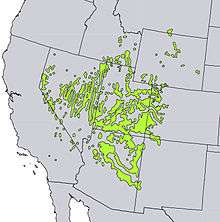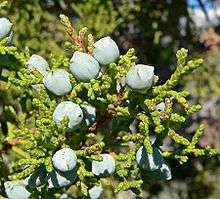Juniperus osteosperma
| Juniperus osteosperma | |
|---|---|
 | |
| A Utah juniper showing distinctive shape and leaves | |
| Scientific classification | |
| Kingdom: | Plantae |
| Division: | Pinophyta |
| Class: | Pinopsida |
| Order: | Pinales |
| Family: | Cupressaceae |
| Genus: | Juniperus |
| Species: | J. osteosperma |
| Binomial name | |
| Juniperus osteosperma (Torr.) Little, 1948 | |
 | |
| Natural range | |
Juniperus osteosperma (Utah juniper; syn. J. utahensis) is a shrub or small tree reaching 3–6 m (rarely to 9 m) tall. It is native to the southwestern United States, in Utah, Nevada, Arizona, western New Mexico, western Colorado, Wyoming, southern Montana, southern Idaho and eastern California. It grows at moderate altitudes of 1,300–2,600 metres (4,300–8,500 ft), on dry soils, often together with Pinus monophylla.

The shoots are fairly thick compared to most junipers, 1.5–2 mm diameter. The leaves are arranged in opposite decussate pairs or whorls of three; the adult leaves are scale-like, 1–2 mm long (to 5 mm on lead shoots) and 1–1.5 millimetres (0.039–0.059 in) broad. The juvenile leaves (on young seedlings only) are needle-like, 5–10 mm long. The cones are berry-like, 8–13 millimetres (0.31–0.51 in) in diameter, blue-brown with a whitish waxy bloom, and contain a single seed (rarely two); they are mature in about 18 months. The male cones are 2–4 millimetres (0.079–0.157 in) long, and shed their pollen in early spring. It is largely monoecious with both sexes on the same plant, but around 10% of plants are dioecious, producing cones of only one sex.

The plants frequently bear numerous galls caused by the Juniper Tip Midge Oligotrophus betheli (Bibionomorpha: Cecidomyiidae); these are conspicuous pale violet-purple, produced in clusters of 5-20 together, each gall 1–2 centimetres (0.39–0.79 in) diameter, with dense modified spreading scale-leaves 6–10 millimetres (0.24–0.39 in) long and 2–3 millimetres (0.079–0.118 in) broad at the base. Seeds are dispersed by Jackrabbits (mostly the Black-tailed Jackrabbit Lepus californicus spp.) rodents and to a lesser extent by coyotes (Canis latrans).

See also
References
- R.P. Adams. Junipers of the World: The genus Juniperus. Trafford Publishing ISBN 1-4120-4250-X
- J.C. Chambers, S.B. Vander Wall and E.W. Schupp. 1999. Seed and seedling ecology of piñon and juniper species in the pygmy woodlands of western North America. Botanical Review 65: 1-38.
External links
| Wikimedia Commons has media related to Juniperus osteosperma. |
- USDA Plant Profile: Juniperus osteosperma
- Gymnosperm Database: Juniperus osteosperma
- Flora of North America: Juniperus osteosperma
- Jepson Manual - Juniperus osteosperma
- Juniperus osteosperma - Photo Gallery
- Conifer Specialist Group (1998). "Juniperus osteosperma". IUCN Red List of Threatened Species. Version 2006. International Union for Conservation of Nature. Retrieved 12 May 2006.
- Interactive Distribution Map of Juniperus osteosperma
